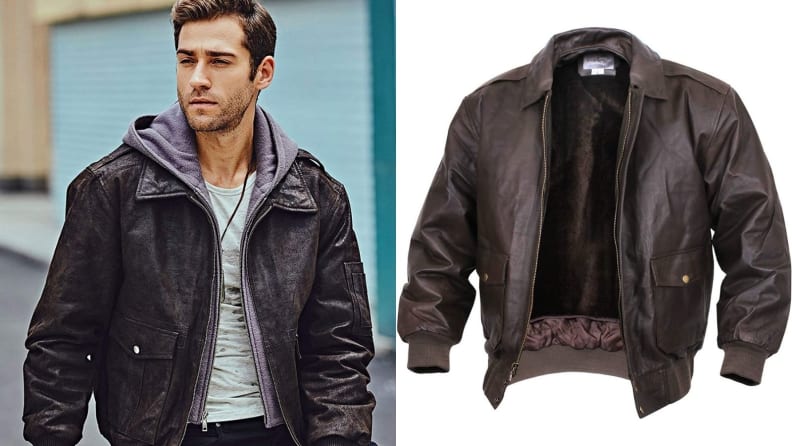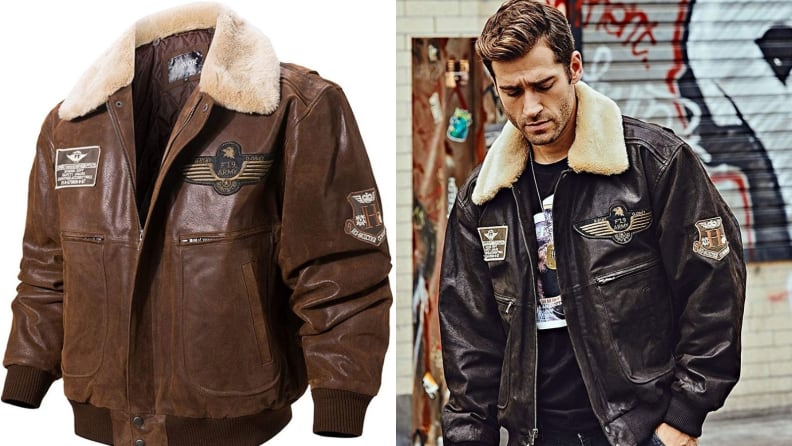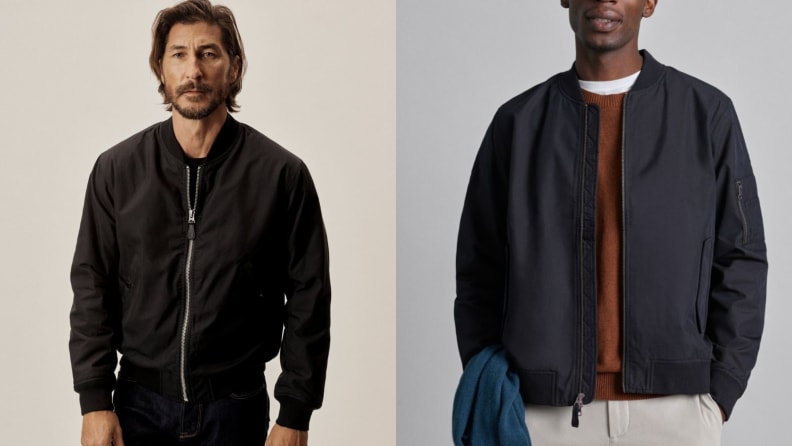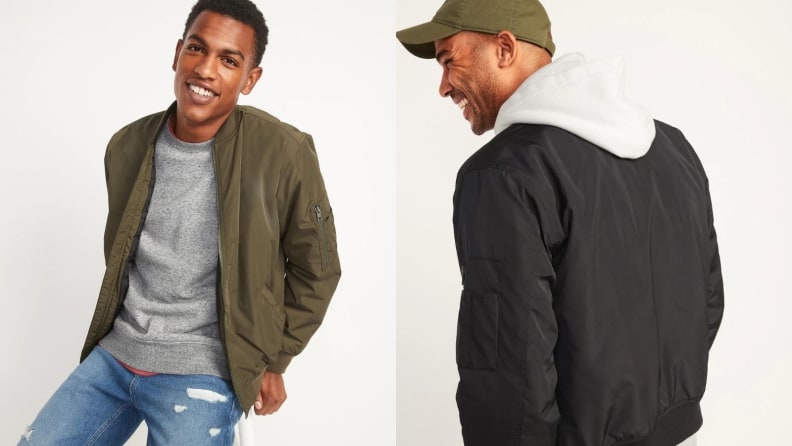All about the bomber jacket—from World War I to layering essential
How the piece went from military wear to civilian staple
Products are chosen independently by our editors. Purchases made through our links may earn us a commission.
Ah, the bomber jacket. Cozy, trim, and like a ton of other items within fashion, derived from the military. But how did they become a civilian staple, like locker loops on button-down shirts and Ray-Ban sunglasses?
What is a bomber jacket?
A bomber jacket, interchangeably referred to as a flight jacket, was originally conceived during World War I as outerwear to keep pilots warm during—you guessed it—flight. The U.S. Army established the Aviation Clothing Board in September of 1917 and began issuing flight jackets at a time when fighter cockpits, terrifyingly, were not fully enclosed. These jackets traditionally were made of leather, which wind can’t permeate, and featured wraparound collars and zipper closures, snug cuffs and waists (also to keep air out), and sometimes were lined with fur.
The flight jacket’s design has seen multiple updates over the years to coincide with technological advances in aviation. As planes began ascending at higher altitudes, cockpit temperatures dropped lower, even with the eventual addition of a fully enclosed cockpit. During World War II, bombing raids saw pilots soaring at elevations as high as 25,000 feet, where temperatures could reach as cold as −30°F. As the world’s militaries entered the jet age—an era in which aircrafts replaced propellers with the newly invented jet engine—jacket construction dropped heavy leathers in favor of lighter materials and fabrics, like polyester and nylon, to provide better water resistance as well as more mobility for its pilots in smaller places.
What are the most famous styles of bomber jackets?
Generally speaking, three types of bomber jackets hold court within pop culture: the all-leather A-2, the updated leather G-1, and the nylon MA-1.
A-2 bomber jacket

The A-2 is the original leather flight jacket.
The A-2 leather flight jacket was standardized in May 1931 and was manufactured until 1943. It was issued and used by the United States Army Air Corps and United States Army Air Forces until the end of World War II and is considered the most famous WWII flight jacket. The A-2 is also the jacket that Steve McQueen famously wore in the 1963 Nazi POW movie The Great Escape.
A standard A-2 flight jacket features two snap-flap pockets, a snap-down collar, shoulder straps, and knit cuffs and waistband, and consists of a one-piece leather back and two leather pieces for sleeves. Perhaps annoyingly for pilots, both front pockets weren’t meant for warming hands, as the military deemed hands inside of pockets to be inappropriate for active troops. Unlike its predecessor, the A-1, the A-2 featured a front zipper instead of a button closure to also help eliminate the breeze. These jackets fit trim in order to keep the pilot comfortable in their cockpit.
Earlier versions of the A-2 were made with horsehide, while later versions used goatskin and cowhide. No matter the leather type, they were issued in russet (red-brown), seal brown (dark brown to black), and medium brown colors.
You can find newer versions of the A-2 bomber jacket at many replica and military retailers such as Landing Leathers, Rothco, Overland, and Flavor. You can even find one at Lands’ End. If you’re looking for something vintage with aged leather, eBay and Etsy have plenty of secondhand finds.
G-1 military flight jacket

The G-1 is a variation of the A-2 with a fleece collar.
Another WWII-era jacket, the G-1 was used by the United States Navy, Marine Corps, and Coast Guard, and has been in service since the 1930s. These are, essentially, A-2 bomber jackets with fur-lined collars, and typically with ornamental patches along the arms and back. For another pop culture reference: The G-1 flight jacket is what Tom Cruise wears in Top Gun. (You can buy a replica of that on eBay, by the way.)
The G-1 has a lot of the makings of an A-2—sheepskin leather, snap-flap pockets, knit cuffs and waistbands—but it differs with two traits: underarm gussets and an extra panel of leather on the back, both for better mobility.
If you’re looking for a standard G-1, you can look at military replica stores and leather shops like Flavor and Landing Leathers. Ones with ornaments and patches can be found at Avirex and Alamodetrend. For the real deal, scan eBay and Etsy to find antique jackets.
MA-1 bomber jacket

A modern bomber jacket, the MA-1 is omnipresent as a casual layering option.
While the classic example of a flight jacket is defined as a G-1 or A-2, the MA-1, as well as its successor the MA-2, is the modern bomber jacket we know and love. Your movie references here include Drive, Rebel Without A Cause, and The Shining.
This jacket was initially developed in the late 1950s in response to the jet age, during a time where cockpits had become less spacious than they once were and new safety measures for piloting aircrafts were put in place. The MA-1 was created to correct issues pilots faced with leather jackets from decades past. If a pilot walked through rain before entering their cockpit, for example, their leather jackets could end up freezing while flying at higher altitudes. Therefore, the MA-1 was built with a nylon shell that repels water away, and a polyester lining for added warmth.
Later, during the Korean War, MA-1 bomber jackets were changed from traditional navy blue to green to help camouflage pilots in forests and jungles. The polyester lining found on the inside of the jacket was typically orange, which served as a rescue signal: If a pilot was in peril and out of their aircraft, they could reverse their jacket as they waited for allies to spot them from a distance. A zippered pocket was also added to the shoulder of the MA-1 so that pilots could store pens or cigarettes, as cockpits shrank in size and room for storage became scarce.
As for the MA-1’s successor, the MA-2, the jackets have minor distinctions. The MA-1 has slash pockets, while the MA-2 has cargo pockets. The MA-1 also has an elasticated collar, whereas the MA-2 has a fold-down collar, and it stacks higher on the waist for a trimmer look.
Many retailers have their own version of the MA-1 bomber jacket, including Everlane, Buck Mason, Old Navy, and Abercrombie & Fitch. Unlike leather flight jackets, vintage MA-1 bombers can be found on eBay and Etsy at lower prices due to their use of more common materials.
When did bomber jackets become popular?

Many retailers now carry a version of the bomber jacket as a fall staple.
So how exactly did the flight jacket become popular in modern fashion? Appropriation, of course. The piece became co-opted as a streetwear staple in the late 1960s and 1970s, when British skinheads—youths who often dressed in combat boots and straight-leg jeans who shaved their heads to show working class solidarity—started wearing MA-1s as a symbol of their subculture. These skinheads, also known as “hard mods,” shaved their heads as a reaction to hippies, a subculture of youth who grew their hair out, and for safety during the occasional street fight. From there, the bomber jacket was seen as a sort of icon for youth rebellion.
As the image of a skinhead became more aligned with openly racist and hateful alt-right spatter, the LGBTQ+ community began appropriating the piece to disrupt the skinhead signaling. In 1984, openly gay synthpop group Bronski Beat released a music video for “Smalltown Boy” which saw lead Jimmy Somerville wear an MA-1, personifying this appropriation and subverting its once controversial imagery. Not long after, the piece was introduced to high fashion as French designer Jean Paul Gaultier interpreted the jacket for women in 1988, later designing a version of Madonna.
Ever since, the modern MA-1 has remained in vogue as one of the most popular pieces in outerwear fashion, sprawling across multiple subcultures across the world, especially within hip-hop during the late 1990s and early 2000s. The G-1 and A-2, meanwhile, remain classically handsome pieces from Hollywood.
